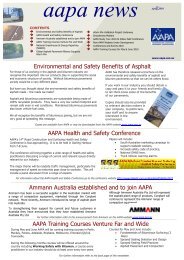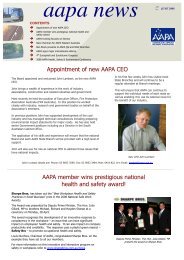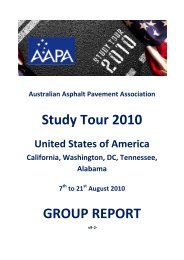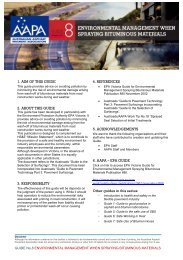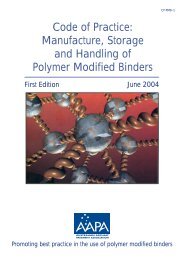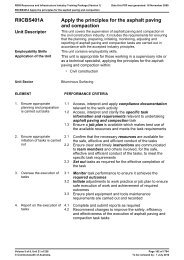Asphalt Review - Volume 32 Number 3 (Jun / Juy 12) - Australian ...
Asphalt Review - Volume 32 Number 3 (Jun / Juy 12) - Australian ...
Asphalt Review - Volume 32 Number 3 (Jun / Juy 12) - Australian ...
Create successful ePaper yourself
Turn your PDF publications into a flip-book with our unique Google optimized e-Paper software.
ASPHALT REVIEWBackground onthe NCAT Test TrackThe NCAT Pavement Test Track, operated bythe National Center for <strong>Asphalt</strong> Technology(NCAT), has been a successful pavementresearch program for many reasons. First, the1.7-mile oval test track is a unique acceleratedpavement testing facility that brings togetherreal-world pavement construction with liveheavy trafficking for rapid testing and analysisof asphalt pavements.Since the test track is funded and managedas a cooperative project, highway agenciesand industry sponsors have specific researchobjectives for their section(s) and sharedobjectives for the track as a whole.The results of the experiments are notabstract or ambiguous; they are easy tointerpret, so findings are quickly put intopractice by sponsors. Highway agencies haveused test track findings to improve theirasphalt mix specifications, constructionpractices, and pavement design methods.Industry sponsors have used the test trackas a proving ground to publicly demonstratetheir technologies to the pavementengineering community.The track has 46 different 200-ft. testsections. Twenty-six sections are located onthe two straight segments of the track, andten sections are located in the two curves.Sections are sponsored on three-year cycles.The first part of each cycle begins withbuilding or replacing test sections, whichnormally takes about six months.Trafficking is applied over a two-yearperiod using a fleet of heavily loadedtractor-trailer rigs to provide the equivalentof 10 million 18,000 pound single-axleloads (ESALs). During the trafficking phase,performance of the test sections is closelymonitored using surface measurements andnon-destructive structural response methods.Also during the trafficking phase, samplesof the mixtures obtained during constructionare tested and analyzed in NCAT’s stateof-the-artlaboratory. The final part of thecycle involves forensic analyses of damagedsections to determine factors that may havecontributed to the distresses.The referenced report documents theexperiments, analyses, and findings fromthe fourth cycle of the test track that wasconducted from 2009 to 2011.The first test track cycle began in 2000. Thetrack was originally constructed to evaluate42 ROADS JUNE/JULY 20<strong>12</strong>only surface mix performance for all 46 testsections. The pavement structure under thetest sections was built extremely thick (20inches of HMA over a granular base and a stiffsubgrade) so that damage would be limitedto the surface layers in the test sections.The second cycle, started in 2003, includedreplacing 24 test sections. Eight of thosesections were the first “structural sections”designed and built to analyze the entirepavement structure, not just the surfacelayers. Construction of the structural sectionsrequired removal of the original thickpavement structure down to the subgradematerial, then rebuilding the subgrade,aggregate base, and asphalt layers to resultin test sections with asphalt pavementthicknesses of five, seven, and nine inches.Strain gauges were built into the bottom ofthe asphalt layers of the structural sectionsto monitor how the sections respondedto the traffic and environmental changesthroughout the two-year trafficking phase.This analysis was important to validate andcalibrate elements of the new Mechanistic-Empirical Pavement Design Guide (MEPDG).The 2003 cycle also included the evaluationof 14 new surface layers. The remainingoriginal 26 test sections were left in placewith no changes to further evaluate theirperformance through the second cycle.The third cycle of the test track startedin 2006. Twenty-two new sections werebuilt in 2006, including 15 new surface mixperformance sections, five new structuralstudy sections, and two reconstructedstructural sections. Sixteen sections fromthe second cycle remained in place and hadaccumulated 20 million ESALs at the end ofthe third cycle. Eight original sections builtin 2000 remained in place and accumulated30 million ESALs by the end of the thirdcycle in 2008.Overview of the 2009Test Track (Fourth Cycle)As with the previous two cycles, the 2009 testtrack included new sections and continuedevaluation of existing sections. Of the 46 totalsections, 25 new experimental pavementswere built, nine were left in place from the2006 cycle, nine were left in place from the2003 cycle, and three sections remained fromthe original construction.The research objectives for the 2009test track are described in the report inalphabetical order by sponsor. Six agenciesworked together to establish a group ofexperimental test sections with a commoncross-section to assess the performance andstructural response of pavements constructedwith warm-mix asphalt (WMA) technologies,high RAP contents, the combination of highRAP content and WMA, and a porous frictioncourse containing 15% RAP.This collection of six test sections has beenreferred to as the “Group Experiment,” whichincludes:1. A control section built with three densegradedlayers of hot-mix asphalt using allvirgin materials;2. A section built with an open-gradedfriction course as the surface layer in placeof the dense-graded surface course in thecontrol section;3. A section using the same layers and mixdesigns as the control section except themixes were produced as WMA using a waterinjectionfoaming process;4. A section using the same layers andmix designs as the control section exceptthe mixes were produced as WMA using achemical additive;5. A section with mix designs containing50% RAP in each of the three layers; and6. A section with the same 50% RAP mixdesigns except the mixtures were producedas warm-mix asphalt using a water-injectionfoaming processAll of the Group Experiment sections wereconstructed on the same stiff subgrade andgraded aggregate base. A designed asphaltpavement thickness of seven inches wasselected for all the Group Experiment testsections because previous test sections builtwith that thickness had exhibited moderatefatigue cracking within one cycle.Therefore, the Group Experiment testsections were expected to have a rangeof fatigue cracking due to different mixproperties used in the sections. Specificobjectives of the Group Experiment were to:1. Compare dense-graded HMA to PFCsurface layer with regard to structuralresponse to determine how PFC mixes shouldbe treated in structural pavement design;



